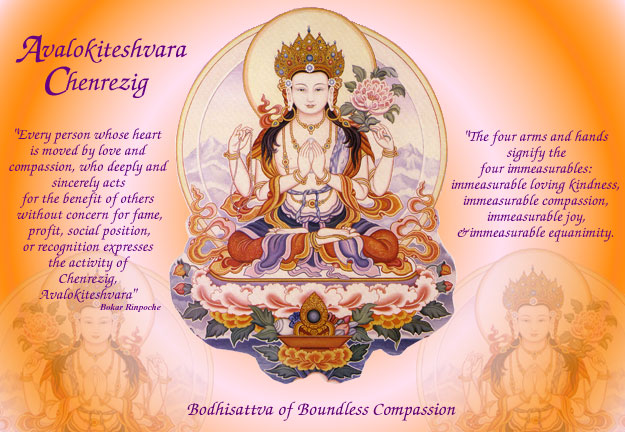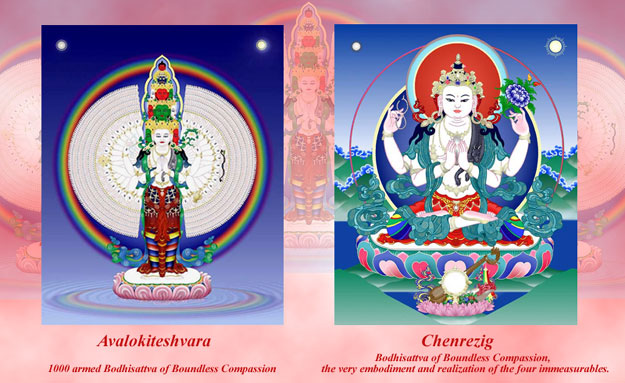
Of all the deities in Mahayana Buddhism, the bodhisattva Avalokiteshvara, Chenrezig, is one of the most celebrated. He is the lord endowed with complete illumination, who refrains from entering the blissful state of nirvana to remain here below and save the creatures of the earth. This devotion to the salvation of others emphasizes the profound compassion this bodhisattva represents.
A bodhisattva was thought of as a being no longer subject to the physical limitations of human life, or who was limited by thoughts of themself. They inhabited a "celestial" realm, a spiritual field brought into being by their own saintliness. It was into this blessed realm of being that they were believed to be able to bring others by their own spiritual power.
Compassion for others had always been regarded as a virtue in early Buddhism, but it had a somewhat subordinate place to wisdom. In Mahayana Buddhism, compassion received an equal emphasis with wisdom, perhaps because the Mahayana was more consciously universal and covered a wider sector of society. In this view of the world, all men and women, not just those leading a monastic life, could achieve nirvana.
Avalokiteshvara, the merciful, is also called Padmapani. A transformation of this bodhisattva took place in China. As if in honor of his powers of love, the Chinese Buddhists portrayed him as a woman, the goddess Kuan-Yin, who cradles the symbol of the soul in her arms and resembles the Virgin Mary. In contrast to this concrete effigy, India sees this sympathetic savior as a cosmic being who takes countless shapes:
From his eyes come forth the sun and moon; from his brow, Mahesvara, the great god who creates life with a thunderbolt from his third eye; from his shoulders, Brahma and other gods; from his heart, Narayana, the soul of the universe; from his thighs, Sarasvati, the wife of Brahma and the goddess of wisdom, music, and science; from his mouth, the winds; from his feet, the earth; from his stomach, Varuna, an emanation from the sun initiating the cycles of nature and the embodiment of truth. He is a lamp to the blind, a parasol for those devoured by the heat of the sun, and a stream to the thirsty. He takes away all fear from those who are afraid; he is a doctor to the sick, and he is father and mother to the unhappy. (*)
In the Tibetan Buddhist pantheon of enlightened beings, Chenrezig, Avalokiteshvara, is renowned as the embodiment of the compassion of all the Buddhas, the Bodhisattva of Compassion.
Chenrezig is considered the patron bodhisattva of Tibet, and his meditation is practiced in all the great lineages of Tibetan Buddhism. The beloved king Songtsen Gampo was believed to be an emanation of Avalokiteshvara, and some of the most respected meditation masters (lamas), like the Dalai Lamas and Karmapas who are considered living Buddhas, are also believed to be emanations of Avalokiteshvara.
Avalokiteshvara is the earthly manifestation of the self born, eternal Buddha, Amitabha. He guards this world in the interval between the historical Sakyamuni Buddha, and the next Buddha of the Future, Maitreya.
According to legend, Avalokiteshvara made a vow that he would not rest until he had liberated all the beings in all the realms of suffering. After working diligently at this task for a very long time, he looked out and realized the immense number of miserable beings yet to be saved. Seeing this, he became despondent and his head split into thousands of pieces. Amitabha Buddha put the pieces back together as a body with a thousand arms, an eye on each palm to see the suffering in the world and eleven heads, the top of which is Amitabha, allowing Avalokiteshvara to assist the myriad of sentient beings all at the same time.
Avalokiteshvara, Chenrezig, is visualized in many forms, with various numbers of faces and arms, and various colors and ornaments.

The radiant white Buddha form representing purity and power of the enlightened mind's loving kindness and compassion is illustrated above and at the very top of this page.
We may visualize him as a transparent, rainbow like form, like a reflection in water, representing the empty and open aspect of awakened mind. He transcends the solidification of concepts, including our idea that he is "out there," separate from us.
He sits on a lotus and the flat disc of the moon, with another moon disk behind him, reflecting his total purity. Two of his four arms are joined in the prayer position holding the wish fulfilling gem. In his other left hand he holds a lotus flower and in his other right hand, a crystal mala (rosary), which he is using to count the repetitions of his mantra, Om Mani Padme Hum, Hail to the Jewel in the Lotus, which liberates all beings from suffering. He wears the silks and ornaments of a Bodhisattva, representing all his special qualities, and the soft skin of an antelope over his shoulder, symbolizing his complete freedom from violence. He smiles with deep understanding, love and compassion as his eyes look upon all beings.
The four arms and hands signify the four immeasurables: immeasurable loving kindness, immeasurable compassion, immeasurable joy, and immeasurable equanimity. Chenrezig, the Bodhisattva of Boundless Compassion, is the very embodiment and realization of the four immeasurables. The four immeasurables are the vehicles through which Chenrezig benefits beings.
"The first two, the inner arms, have palms joined at the heart, holding a sky-blue, wish fulfilling jewel." (**)This symbolizes that in whatever way Chenrezig manifests to benefit beings, the quality of Chenrezig's mind is never separate from the all pervasive primordial wisdom.
In the outer right hand, Chenrezig is holding crystal beads and moving them the way we use a mala to count mantras. This symbolizes that there is not one moment when Chenrezig does not benefit beings. Like the steady movement of counting the beads, Chenrezig is continuously benefiting sentient beings and turning the wheel of enlightened activity.
In the outer left hand, Chenrezig holds a lotus flower. This symbolizes that in benefiting sentient beings, Chenrezig manifests in whatever forms are necessary in accordance with the mental capacities, circumstances, and aptitudes of sentient beings. Chenrezig may appear in any of the different realms, such as the hell realm or the hungry ghost realm.
However Chenrezig may appear, s/he remains free from any of the samsaric stains of the various realms, the way a lotus flower growing in a swamp appears free of the stain of the mud. The left hand of Chenrezig, holding the flower, symbolizes that stainlessness.
All the various features of this image have meaningful connections to the wonderful qualities of Chenrezig, and by focusing on these details as we visualize the image in the meditation, we can gradually awaken our own awareness of those same qualities in ourselves.

Click
on graphic for larger version of image
Having trouble seeing how your real nature could be no different from that of a being who constantly manifests unsurpassable intelligence, wisdom, compassion, and confidence? We know we're not always compassionate, that we care much more about the well being of certain people than about others, that we hardly know what it would mean to give without expecting anything in return. The descriptions of Chenrezig as consistently compassionate to all beings, impartially, is not a common occurrence in our experiences.
The image of Chenrezig that is visualized in the meditation practice is not a real person who happens to be perfect in every imaginable way. It is an image, an imaginary form with wonderful qualities. Chenrezig glows in the dark, Chenrezig even glows in the daylight. Kalu Rinpoche said, "One does not think of the deity's body as solid or material, made of flesh and blood like one's ordinary body, or made of metal or stone like an idol. One thinks of it as appearance that is inseparable from emptiness, like a rainbow or like a reflection in a mirror."
The particular wonderful qualities that Chenrezig manifests for us are just the ones we need to get more in touch with, as aspects of our own nature, if we want to become an enlightened buddha, or even if we just want to become a truly compassionate person. We and the image of Chenrezig are two extremes ~ we have flesh and blood bodies, but not as much compassion as we would like to have, and Chenrezig has a body made of rainbows, and boundless impartial compassion. When we put those two extremes together, in the Chenrezig meditation, we move in the direction of manifesting as a being with a physical body, a body of rainbow light and unlimited compassion.
Various aspects of the form we visualize remind us of the most important qualities of this particular manifestation of awakened mind, the qualities we are trying to connect to.
In visualization practice we imagine ourselves to be a Buddha, in this case the Buddha of Compassion, Avalokiteshvara. By replacing the thought of yourself as you, with the thought of yourself as Avalokiteshvara, you gradually reduce and eventually remove the fixation on your personal self, which expands your loving kindness and compassion, toward yourself and toward others, and your intelligence and wisdom becomes enhanced, allowing you to see clearly what someone really needs and to communicate with them clearly and accurately.
Avalokiteshvara, Chenrezig is the embodiment of that unselfish urge to look upon each other as loving equals. If you are in need of guidance in healing, unity, unselfishness, or the mastering of fears, you may meditate on the qualities of Avalokiteshvara, Chenrezig {as above}, say the mantra Om Mani Padme Hum, Hail to the Jewel in the Lotus, or you can do the following meditation.
This meditation on the thousand armed Avalokiteshvara is a visualization which appeared when a friend asked for spiritual guidance to alleviate her suffering ... feel free to experiment with each meditation technique.
Find a quiet and comfortable space. Then, while breathing deeply for a few moments, relax and empty your mind. In that void, picture Avalokiteshvara standing in front of you. Repeat his name. Then imagine streams of violet light flowing from his thousand eyes piercing the veils of glamours and illusions, dispelling all fear and suffering surrounding you.
As you experience the veils lifting, see His thousand arms transform into shimmering threads of golden light surrounding you in a translucent cocoon of gold. Remain in His "embrace," in complete silence, until you experience a fully open heart and a peaceful mind. Place your consciousness at the top of your head. At your crown see a thousand-petaled lotus bursting through the cocoon of gold, unfolding, revealing a diamond at its very center, radiating rainbow hued swirling vortexes of light. Radiating from your crown and heart center, the energies unite transforming into a thousand arms~like wings of an angel~each possessing and bestowing enlightened compassion. Transformed, you emerge the embodiment of compassion.
Go forth and serve ... Buddhas All! As a person think in their heart, so shall they be!
 Click
on graphic for larger version of image
Click
on graphic for larger version of image
In most religious traditions one prays to the deities of the tradition in the hopes of receiving their blessing, which will benefit one in some way. In the Vajrayana Buddhist tradition the blessing and the power and the superlative qualities of the enlightened beings are not considered as coming from an outside source, but are believed to be innate, to be aspects of our own true nature. Avalokiteshvara, Chenrezig, and his love and compassion are within us.
His Holiness The Dalai Lama said, "Thus the six syllables, Om Mani Padme Hum, mean that in dependence on the practice which is in indivisible union of method and wisdom, you can transform your impure body, speech and mind into the pure body, speech, and mind of a Buddha."
The Mani mantra is the most widely used of all Buddhist mantrams, and open to anyone who feels inspired to practice it.
Before attempting ... we suggest reading The True Sound of Truth, a wonderful story dispelling the "fear of reciting it wrong" ....

|

|

|

|

|

|

|
The Mantra Om Mani Padme Hum ~ Om (ohm) Ma (mah) Ni (nee) Pad (pahd) Me (may) Hum (hum)
"Hail to the Jewel in the Lotus"
The six syllables of the mantra ~ Om Mani Padme Hum ~ are here written in the Tibetan alphabet:

Reading from left to right the syllables are
Om (ohm) Ma (mah) Ni (nee) Pad (pahd) Me (may) Hum (hum)
The vowel in the syllable Hu is pronounced as in the English word "book."
The final consonant in that syllable is often pronounced "ng" as in "song." Om Mani Padme Hung.
The syllable Pad is pronounced Pe (peh) by many Tibetans: Om Mani Peme Hung.
At the heart of this mantra is the seed syllable "Om" which represents the underlying unity of all things.
Sanskrit form ~ Om Mani Padma Hum ~ mantra of Avalokiteshvara
Tibetan form ~ Om Mani Peme Hung ~ mantra of Chenrezig
Meaning, "Hail to the Jewel in the Lotus."
The Dalai Lama explains the meaning of this mantram,
It is very good to recite the mantra Om mani padme hum, but while you are doing it, you should be thinking on its meaning, for the meaning of the six syllables is great and vast.
The first, Om ... symbolizes the practitioner’s impure body, speech and mind; they also symbolize the pure exalted body, speech and mind of a Buddha ....
The path is indicated by the next four syllables. Mani, meaning jewel, symbolizes the factors of method ~ the altruistic intention to become enlightened, compassion, and love ....
The two syllables padme, meaning lotus, symbolize wisdom ....
Purity must be achieved by an indivisible unity of method and wisdom, symbolized by the final syllable hum, which indicates indivisibility.
A devoted meditator, after years concentrating on a particular mantra, had attained enough insight to begin teaching. The student's humility was far from perfect, but the teachers at the monastery were not worried.
A few years of successful teaching left the meditator with no thoughts about learning from anyone; but upon hearing about a famous hermit living nearby, the opportunity was too exciting to be passed up.
The hermit lived alone on an island at the middle of a lake, so the meditator hired a man with a boat to row across to the island. The meditator was very respectful of the old hermit.
As they shared some tea made with herbs the meditator asked him about his practice. The old man said he had no spiritual practice, except for a mantra which he repeated all the time to himself. The meditator was pleased: the hermit was using the same mantra he used himself ~ but when the hermit spoke the mantra aloud, the meditator was horrified!
"What's wrong?" asked the hermit.
"I don't know what to say. I'm afraid you've wasted your whole life! You are pronouncing the mantra incorrectly!"
"Oh, Dear! That is terrible. How should I say it?"
The meditator gave the correct pronunciation, and the old hermit was very grateful, asking to be left alone so he could get started right away. On the way back across the lake the meditator, now confirmed as an accomplished teacher, was pondering the sad fate of the hermit.
"It's so fortunate that I came along. At least he will have a little time to practice correctly before he dies." Just then, the meditator noticed that the boatman was looking quite shocked, and turned to see the hermit standing respectfully on the water, next to the boat.
"Excuse me, please. I hate to bother you, but I've forgotten the correct pronunciation again. Would you please repeat it for me?"
"You obviously don't need it," stammered the meditator; but the old man persisted in his polite request until the meditator relented and told him again the way he thought the mantra should be pronounced.
The old hermit was saying the mantra very carefully, slowly, over and over, as he walked across the surface of the water back to the island.
In the words of Tarthang Tulku, "Compassion accepts others as they are. One who thoroughly realizes compassion no longer sees any separation between self and others. Compassion is the wholesome and spontaneous response to all situations."
May these ancient teachings bring you enlightenment, and may you share it freely with those around you. Blessings!
|
Thank You for Your Heartfelt |
Healing
Deities~Ganesh
Healing Deities~Shiva
Healing Deities~The Christ
Healing Deities~Blue Medicine Buddha
Healing Deities~Queen Mayadevi
Healing Deities
The Blue Pearl
Compassion Prayer
Healing Arts
Linkups~SouledOut.org's
Recommended Links
Glossary of Esoteric Terms & Phrases
SouledOut.org Site Map
SouledOut.org Home
Top
Graphic: adaptation of "Chenrezig"
© Marianna
Rydvald, Dakini
Unlimited, Maui
Excerpts and
illustrations appropriated from
Dharma
Haven website
Further
excerpts from
* Purify Our
Mind
[return to place in text]
and from
** Karma Triyana
Dharmachakra
[return to place in text]
Background & lower
page graphics appropriated from
Osel
Shen Phen Ling Tibetan Buddhist Center
Wonderful site to visit for further studies on
Tibetan Buddhism and Buddhist deities

